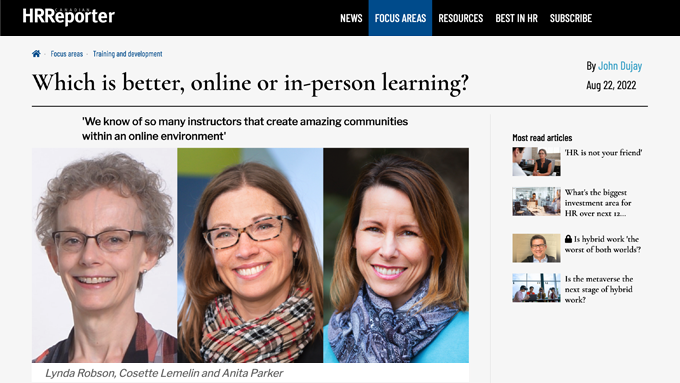Which is better, online or in-person learning?
23 August 2022

'We know of so many instructors that create amazing communities within an online environment'
By John Dujay, News Editor, Canadian HR Reporter
Aug 22, 2022
As many workplaces moved to online environments during the pandemic, training and development followed suit and many employees took courses in a virtual environment.
In a post-COVID world, should learning continue to be conducted online, or would workers be better served by having all education go back to in-person again?
Researchers at the Institute for Work and Health (IWH) in Toronto decided to look for an answer.
“We wanted to provide the research evidence that would help inform that decision of whether to go back to the way things were being done,” says Lynda Robson, scientist at IWH in Toronto, who conducted the study.
Notably, there are not a lot of studies on the topic, she says: Out of 1,653 unique reviews found in the search process, only three met the inclusion criteria.
“We searched for systematic reviews that have looked at this question of synchronous online learning versus in-class: what is the difference in their effectiveness? We found three published between 2010 and 2020, and those three reviews did not show a difference,” says Robson.
Ultimately, no difference was found between synchronous or real-time online learning and face-to-face learning in their effects on knowledge or skills. The study, “A rapid review of systematic reviews on the effectiveness of synchronous online learning in an occupational context,” was also conducted by Emma Irvin, Kathy Padkapayeva, Momtaz Begum and Melanie Zukowski.
More study is needed, says Robson, who is currently working on research comparing the experiences of people learning in different ways.
“There would need to be more research on the effectiveness of different modalities for more practical, hands-on type of learning and there also needs to be more research on people with different types of educational preparation, not just university preparation, and at least for our area of occupational health and safety training, we need more research in that area too.”
Pros and cons to both
So, is online teaching here to stay?
“Online learning is really part of the path forward as institutions figure out how to bring in students, fill classrooms and offer the programs that they offer; online is definitely part of the of the mix for the viability of programs and entire institution,” says Anita Parker, lead educational developer, provost and vice-president academic at the Centre for Teaching and Learning (CTL), which is part of the University of Alberta in Edmonton.
Online learning is much less costly, says Robson, as it doesn’t include such things as transportation or meals, for example.
Plus, “you don’t have geographical barriers and so you might be able to get training sooner, instead of waiting until it’s available in your local area.”
In-person teaching provides a way for students and educators to “sequester” themselves and fully concentrate on the teaching, which sometimes proves challenging during an online session.
“It’s easy learning online to be pulled in many different directions; just on the very devices that we are learning on, there are all kinds of opportunities for distractions. Whether we’re listening to a lecture on our phone or whether we’re on our laptop, it was a challenge before the pandemic and I would say it’s even more of a challenge in our present time,” says Cosette Lemelin, assistant director at CTL.
Instructors make a difference
Nothing can recreate the “community” that is created in class, says Parker. “Instructors can read students’ body language; they can respond to these [students] in the moment and have the luxury of having just the students in the classroom and can go a little bit more on the fly or can steer the lesson plan in the direction students are needing and that may not quite… as possible in online learning.”
However, this can be replicated to some degree by effective online instructors, says Parker.
“We know of so many instructors that create amazing communities within an online environment. It’s not impossible to create the community and the social presence, especially when they have a synchronous component when the students are brought together by way of videoconferencing.”
It has less to do with the mode of delivery and more to do with many other factors of teaching and learning such as: the preparation and the engagement level, the communication by the instructor, the things that the instructor does to get ready to take the course and then in the action of teaching the course… the quality of the instructional design and the resource provided, the activities that are done in class, whether synchronous online or in person,” she says.
Hybrid learning
One idea that combines both is hybrid learning, “where instructors are in real-time teaching — they might be in a classroom or a lab or a clinical setting — with some students in attendance in person, and some students in remotely by video conferencing,” says Parker.
This concept is catching on with some institutions, she says, “especially in graduate programs where the students likely have more life commitments with family and jobs. But it’s one of those things that have been fast-tracked by the pandemic, where it is a necessary ingredient for higher institutions to move forward in the post-pandemic time.”
Students are going to find themselves in hybrid workplaces, and any experience that they have at the undergraduate or graduate level further prepares them for that real-world situation, says Lemelin.
“They’re going to be engineers who work on teams that go far beyond geographical borders and across the globe with teams of people.”